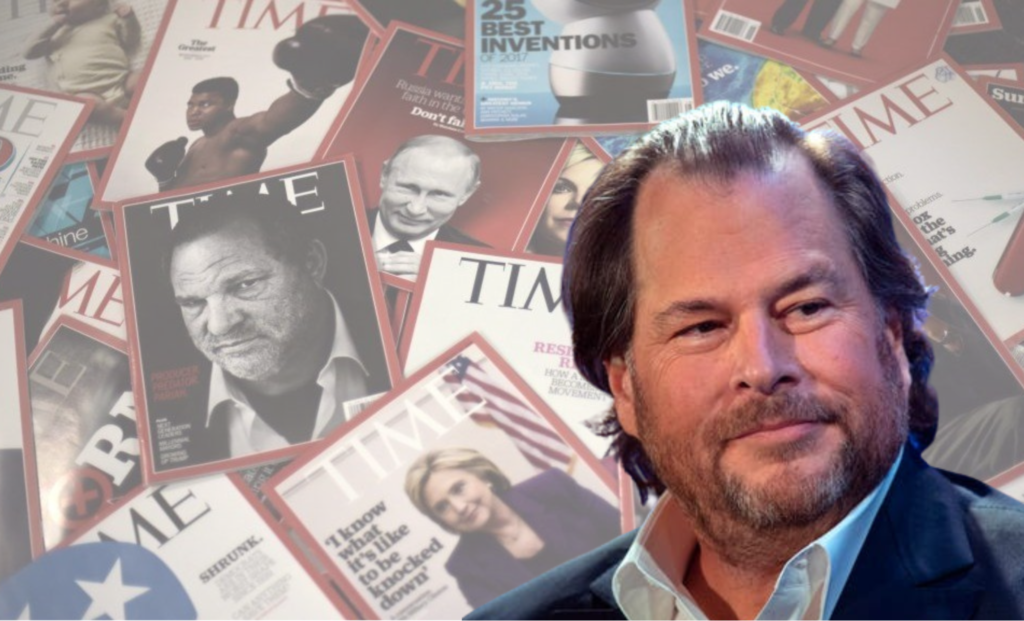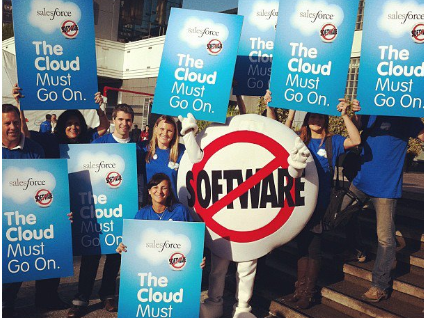The world of Salesforce is certainly vast, with new updates and enhancements happening all the time. The chances are that you can learn new things about it every day, no matter which area you work in. Ever since philanthropic founder, Marc Benioff, started the business in 1999, Salesforce has been breaking boundaries in the CRM world to transform sales, marketing, and technology.
There’s plenty of information on Salesforce out there, but here are 15 interesting facts that you might not know. Enjoy!
1. The 6-Month Sabbatical
Have you ever wondered how the idea of Salesforce actually came to be? Would your first answer be a 6-month sabbatical in India and Hawaii?
If so, you would be right! A 31-year-old Marc Benioff felt uninspired and took a 6-month sabbatical that spurred a lifelong interest in yoga and Eastern religions. It was on this trip that Benioff came up with the idea of Salesforce: a cloud-based CRM that could be used as easily as Amazon.

2. Salesforce Towers
Maybe you’ve heard of Salesforce Tower, but did you know that it’s the tallest building in San Francisco? Standing at a mighty 1,070 feet tall, it towers over both The Shard and even the Eiffel Tower!
Other prominent Salesforce towers are in cities such as London, Tokyo, Chicago, and Sydney. Although the San Fran tower remains the tallest, the others are definitely something to talk about – full of social areas and collaborative workspaces, this is Marc Benioff’s vision of the Ohana.
3. Salesforce and Amazon
What do Amazon and Salesforce have in common, apart from being extremely successful internet-based companies? Back in the 1990s, Marc Benioff was considering how the Cloud could push beyond the boundaries of the current operating system. He wanted the software to be both cheap to deliver (through the web) and as easy to use as possible. He based what we now know as Salesforce.com on Amazon’s usability.
Amazon has been the king of eCommerce since it launched in 1994 – some say this is down to its pioneering innovations and user-friendly nature. What Salesforce and Amazon have in common, as well as surviving the dot-com bubble, is a very easy-to-use interface, which takes advantage of a clear menu and navigation, so that users know exactly where they are at all times. Here is an interesting quote from Marc Benioff’s book, Behind the Cloud:
“…companies were paying hundreds of thousands to buy and millions to install applications that were costly and frustrating to maintain. We wanted to take advantage of a new platform – the Internet – to deliver business applications cheaply through a Web site that was as easy to use as Amazon.com.”
4. Team Trailblazer
The Trailblazer Community currently stands at a proud +15M people across the globe, and it’s only getting bigger.
Did you know about all the different ways you can meet Trailblazers yourself? Trailblazer Community Groups connect budding Trailblazers to other like-minded people in the ecosystem – you can find your nearest group here.
5. AppExchange vs. App Store
When you think about app stores, one that might pop into your head is the Apple App store. These stores come in handy when you need to download something for your device in a quick and simple way.
However, did you know that the Apple App Store came three years after the release of the AppExchange in 2005? Salesforce had originally planned to call AppExchange the App Store and had trademarked the name before Marc Benioff settled on AppExchange instead.
In an interview, Benioff admitted that he actually gifted the trademarked name to Steve Jobs in 2008 as a show of gratitude for all his support over the years.
6. An Uplifting Workplace
Salesforce products play a part in making online back-end processes just that little bit easier, and the scope of customer satisfaction can be seen in the Salesforce Customer Success report. But did you know that this satisfaction also translates to employees?
According to the latest Mason Frank Career and Hiring Guide, 75% of global employees said that they were satisfied in their job roles. Neat!
7. Taking Over The Times
Time Magazine is widely regarded as one of the most trustworthy sources of journalism in the modern age. With such powerful influence, you might assume that it’s owned by some faceless conglomerate or detached stakeholder… but it’s not! It is actually owned by none other than Marc Benioff, who acquired the magazine in 2018.

8. Tech Gets Spooky
Salesforce has always celebrated holidays in style. In 2018, they dressed up their San Francisco Tower as the Eye of Sauron from Lord of the Rings – it was quite a sight to behold!
In 2023, Salesforce also released a new Halloween badge on Trailhead – “Trick or Trailhead VIII”. Trailblazers were invited to take part in “Astro’s Halloween Carnival” on Trailhead and complete modules to win the spooky limited edition badge.
9. Bret Taylor
Last year it was confirmed that Bret Taylor would be stepping down as Salesforce’s co-CEO. He’s certainly made his mark in the ecosystem, but did you know about his amazing involvement in Google?
In 2003, Taylor joined Google as a Group Product Manager where he actually co-created Google Maps, Google Local, and Google Maps API. He also created the iconic “like” button when he was the Chief Technology Officer at Facebook (now Meta).
10. Over 150,000 Businesses and 70,000 Employees
Just to give you an idea of how expansive Salesforce is, the CRM platform delivers services to over 150,000 businesses and has over 70,000 employees worldwide.
You can ‘meet’ some Trailblazers here.
11. Net Zero for the Win
Sizable companies, like Salesforce, have a duty to aim for sustainable business processes – whatever these may look like. Salesforce got a step closer to their goal in 2021, when they achieved net residual zero emissions across the full value chain. They also reached 100% renewable energy.
Sustainability has been a focus for Salesforce since 2013, so this was a very notable step forward!
12. Pledge 1%
The original 1/1/1 model was an integrated philanthropic model pioneered by Benioff at Salesforce. It is centered around companies contributing 1% of equity, 1% of product, and 1% of employee hours to the community. This was later updated to Pledge 1%.
Salesforce achieves this via the Salesforce Foundation. It contributes free and discounted technology to nonprofits and higher education (Product), provides grants to various charities and communities (Equity), and employees volunteer a certain amount of their time each year (Time). Since the 1/1/1 model’s inception, various other companies have adopted the same model including Google, Workday, Box, and Yelp.
13. Outrageous Marketing Schemes
Back when Salesforce was founded, on-premise servers reigned over the tech industry. Marc Benioff and his team had the mammoth task of convincing the business world that this way of working was ‘old news’, and cloud-based technology was the way forward. When you’re a relatively unknown founder and have a company of fewer than ten people working for you, this is no mean feat.
Competing against these huge software companies required some out-of-the-box thinking. Salesforce’s biggest competitor at the time was Seibel (later acquired by Oracle in 2005) – as Benioff truly believed that on-premise systems were outdated and ineffectual, he decided to take on the big dog!
Salesforce hired fake protestors to stand outside the annual Siebel conference, and protested against the software. They shouted slogans such as: “The internet is really neat… software is obsolete!” They even hired a fake TV crew to cover the event and interview members of the public. Siebel called the police, which gave the unknown brand of Salesforce a massive media buzz, and the “No Software” logo was born.

Siebel held another conference in Cannes, France. Benioff changed his tact for this event, and as most executives would fly into Nice and then take a taxi to Cannes, Salesforce hired all of the airport taxis. The 45-minute ride (paid for by Salesforce) gave them a chance to pitch Salesforce to these IT professionals, providing marketing material and lots of Salesforce logos in the cab. The police were, of course, called, as no other taxis were available!
14. Oracle vs. Salesforce
Oracle and Salesforce, or should I say Larry Ellison (CEO & Founder) of Oracle, and Marc Benioff have a long history together.
Benioff worked at Oracle, and under Ellison’s wing, became the youngest VP ever at aged 25 – by 27, he was already a millionaire. When Benioff wanted to explore other ventures, namely Salesforce, Ellison supported his ideas and gave Benioff a 6-month sabbatical. He even invested the first $2M into Salesforce and joined its board of directors.
Things took a sour turn when Benioff discovered Oracle was developing a competing CRM, and Benioff ensured that Ellison was removed from the board. “I can say I’m the only person who fired Larry Ellison,” Benioff told Fortune.
Since then, Benioff and Ellison have had a seemingly complicated relationship, with both showing great respect for one another, but competing fearlessly at the same time. To make things even more interesting, Salesforce is a big customer – the platform being hosted on Oracle technology!
Salesforce have built a portfolio of +60 companies – this totals over $35B in spending! Most of these companies have now been integrated into Salesforce’s platform. For example, Marketing Cloud used to be called Exact Target, Social Studio was previously known as BuddyMedia & Radian6, and Chatter was known as GroupSwim! Other products such as MuleSoft and Tableau are more recent and have retained their previous names, but have been highly integrated into the platform.
15. Billions Spent on Acquisitions
Salesforce is known for their ever-expanding product suite. They started with Sales CRM and now have products that help customer support, marketing, commerce, analytics, and much more.
Salesforce has an acquisition strategy, which means they tend to acquire companies and then integrate them into their existing product suite. Salesforce products such as Marketing Cloud, Pardot, Commerce Cloud, MuleSoft, and Tableau have all been acquired.
Salesforce have built a portfolio of +60 companies – this totals over $35B in spending! Most of these companies have now been integrated into Salesforce’s platform. For example, Marketing Cloud used to be called Exact Target, Social Studio was previously known as BuddyMedia & Radian6, and Chatter was known as GroupSwim! Other products such as MuleSoft and Tableau are more recent and have retained their previous names, but have been highly integrated into the platform.
Summary
That concludes our roundup of 15 Salesforce facts you may not have known. We bet there are some even more obscure facts out there – we’re always eager to learn more, so let us know in the comments below.
This Pardot article written by:
Salesforce Ben | The Drip
Lucy Mazalon is the Head Editor & Operations Director at Salesforceben.com, Founder of THE DRIP and Salesforce Marketing Champion 2020.
Original Pardot Article: https://www.salesforceben.com/salesforce-facts/
Find more great Pardot articles at www.salesforceben.com/the-drip/
Pardot Experts Blog
We have categorized all the different Pardot articles by topics.
Pardot Topic Categories
- Account Based Marketing (ABM) (7)
- Business Units (14)
- ChatGPT / AI (3)
- Completion Actions (5)
- Connectors (10)
- Custom Redirects (4)
- Data Cloud (3)
- Demand Generation (8)
- Dynamic Content (7)
- Einstein Features (11)
- Email Delivery (17)
- Email Open Rates (3)
- Pardot A/B Testing (2)
- Email Mailability (16)
- Do Not Email (1)
- Double Opt-in (2)
- Opt Out / Unsubscribe (14)
- Email Preferences Page (6)
- Engagement Studio (16)
- Industries (1)
- Non Profit (1)
- Landing Pages (9)
- Lead Generation (1)
- Lead Management (13)
- Lead Routing (3)
- Lead Scoring (16)
- Leads (3)
- Marketing Analytics – B2BMA (9)
- Marketing Automation (1)
- Marketing Cloud (3)
- Marketing Cloud Account Engagement (4)
- Marketing Cloud Growth (2)
- New Pardot Features (6)
- Opportunities (2)
- Optimization (2)
- Pardot Admin (65)
- Duplicates (1)
- Marketing Ops (1)
- Pardot Alerts (1)
- Pardot API (2)
- Pardot Automations (3)
- Pardot Careers (12)
- Pardot Certifications (4)
- Pardot Consulting (1)
- Pardot Cookies (4)
- Pardot Custom Objects (3)
- Pardot Email Builder (8)
- Pardot Email Templates (10)
- HML (6)
- Pardot Events (17)
- Pardot External Actions (1)
- Pardot External Activities (4)
- Pardot Forms (29)
- Form Handlers (8)
- Pardot Integrations (21)
- Data Cloud (2)
- Slack (1)
- Pardot Lead Grading (5)
- Pardot Lead Source (2)
- Pardot Lightning (1)
- Pardot Migration (1)
- Pardot Nurture / Drip Campaigns (2)
- Pardot Personalization (3)
- Pardot Profiles (1)
- Pardot Releases (18)
- Pardot Sandboxes (2)
- Pardot Segmentation (5)
- Pardot Strategy (7)
- Pardot Sync (2)
- Pardot Sync Errors (1)
- Pardot Tracker Domains (5)
- Pardot Training (3)
- Pardot Vs Other MAPs (4)
- Pardot Website Tracking (2)
- Reporting (22)
- Salesforce and Pardot (31)
- Marketing Data Sharing (2)
- Pardot Users (3)
- Salesforce Automation (5)
- Salesforce Flows (2)
- Salesforce Campaigns (22)
- Salesforce CRM (3)
- Record Types (1)
- Salesforce Engage (3)
- Salesforce Queues (2)
- Security and Privacy (1)
- Tags (3)
- The Authors (540)
- Cheshire Impact (9)
- Greenkey Digital (55)
- Invado Solutions (37)
- Jenna Molby (9)
- Marcloud Consulting (6)
- Nebula Consulting (67)
- Pardot Geeks (44)
- Salesforce Ben | The Drip (242)
- SalesLabX (16)
- Slalom (4)
- Unfettered Marketing (51)
- Uncategorized (1)
- Website Tracking (2)
- Website Search (1)
More Pardot Articles
See all posts
This Pardot article written by:
Salesforce Ben | The Drip
Lucy Mazalon is the Head Editor & Operations Director at Salesforceben.com, Founder of THE DRIP and Salesforce Marketing Champion 2020.
Original Pardot Article: https://www.salesforceben.com/salesforce-facts/
Find more great Pardot articles at www.salesforceben.com/the-drip/






